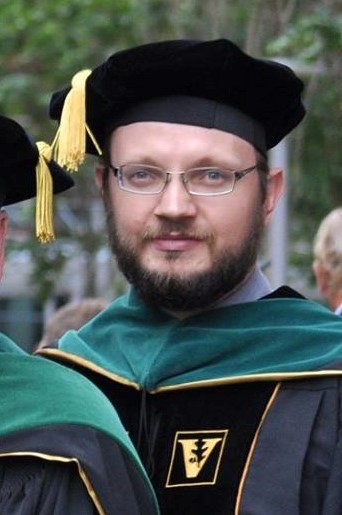MSTPublications: June 2017
MSTPublications: June 2017
Congratulations to all of our MSTP students on their successful publications! Take a look at the great work our students are doing.
First Author Original Research:
 The nesprin-cytoskeleton interface probed directly on single nuclei is a mechanically rich system.
The nesprin-cytoskeleton interface probed directly on single nuclei is a mechanically rich system.
Balikov DA, Brady SK, Ko UH, Shin JH, de Pereda JM, Sonnenberg A, Sung HJ, Lang MJ.
Nucleus. 2017 Jun 22:0. doi: 10.1080/19491034.2017.1322237. [Epub ahead of print]
The cytoskeleton provides structure and plays an important role in cellular function such as migration, resisting compression forces, and transport. These mechanical stimuli can result in genome-level changes, and the physical connection of the cytoskeleton to the nucleus provides an optimal conduit for signal transduction by interfacing with nuclear envelope proteins, called nesprins, within the LINC (linker of the nucleus to the cytoskeleton) complex. However, little is known about the physical dynamics of the interaction of nesprins with their cytoskeletal partners, therefore highlighting an unmet need for new assays that investigate the effects of force on LINC complex proteins, conformational changes and protein-protein/protein-chromatin interactions. Here, we isolated single nuclei and developed a semi-situ single-molecule on single nuclei assay with high spatial (nm), temporal (ms), and force (pN) resolution, allowing for the elucidation of molecular mechanisms previously out of reach, to probe how force inputs are handled at the nuclear envelope at the single protein level via individual cytoskeletal elements bound to beads and actively coupled to the nuclear surface. (By Dan Balikov, M3)
 Tunable Surface Repellency Maintains Stemness and Redox Capacity of Human Mesenchymal Stem Cells.
Tunable Surface Repellency Maintains Stemness and Redox Capacity of Human Mesenchymal Stem Cells.
Balikov DA, Crowder SW, Boire TC, Lee JB, Gupta MK, Fenix AM, Lewis HN, Ambrose CM, Short PA, Kim CS, Burnette DT, Reilly MA, Murthy NS, Kang ML, Kim WS, Sung HJ.
ACS Appl Mater Interfaces. 2017 Jun 16. doi: 10.1021/acsami.7b06103. [Epub ahead of print]
Human bone marrow-derived mesenchymal stem cells (hMSCs) hold great promise for regenerative medicine due to their multipotent differentiation capacity and immunomodulatory capabilities. Substantial research has elucidated mechanisms by which extracellular cues regulate hMSC fate decisions, but considerably less work has addressed how material properties can be leveraged to maintain undifferentiated stem cells. Here, we show that synthetic culture substrates designed to exhibit moderate cell-repellency promote high stemness and low oxidative stress – two indicators of naïve, healthy stem cells – in commercial and patient-derived hMSCs. Furthermore, the material-mediated effect on cell behavior can be tuned by altering the molar percentage (mol%) and/or chain length of poly(ethylene glycol) (PEG), the repellant block linked to hydrophobic poly(ε-caprolactone) (PCL) in the copolymer backbone. Nano- and Ångström-scale characterization of the cell-material interface reveals that PEG interrupts the adhesive PCL domains in a chain length-dependent manner; this prevents hMSCs from forming mature focal adhesions and subsequently promotes cell-cell adhesions that require connexin-43 (CX43). This study is the first to demonstrate that intrinsic properties of synthetic materials can be tuned to regulate the stemness and redox capacity of hMSCs, and provides new insight for designing highly-scalable, programmable culture platforms for clinical translation. (By Dan Balikov, M3)
 A chromosome 5q31.1 locus associates with tuberculin skin test reactivity in HIV-positive individuals from tuberculosis hyper-endemic regions in east Africa.
A chromosome 5q31.1 locus associates with tuberculin skin test reactivity in HIV-positive individuals from tuberculosis hyper-endemic regions in east Africa.Sobota RS, Stein CM, Kodaman N, Maro I, Wieland-Alter W, Igo RP Jr, Magohe A, Malone LL, Chervenak K, Hall NB, Matee M, Mayanja-Kizza H, Joloba M, Moore JH, Scott WK, Lahey T, Boom WH, von Reyn CF, Williams SM, Sirugo G.
PLoS Genet. 2017 Jun 19;13(6):e1006710. doi: 10.1371/journal.pgen.1006710. [Epub ahead of print]
An estimated 10-20% of people living in areas hyperendemic for Mycobacterium tuberculosis (MTB) appear to be resistant to infection. In this study, we sought to identify genetic variants contributing to such resistance by comparing susceptible, HIV-positive individuals in Tanzania and Uganda who did not get infected with Mycobacterium tuberculosis to close contacts who were infected. We identified a genome-wide significant association of a variant near the gene encoding IL-9, a cytokine produced by mast cells and TH2 cells during inflammatory responses. Our association provides a possible link between airway inflammation and protection from MTB infection, suggesting a mechanism for the previously observed inverse relationship between asthma and tuberculosis. (By Rafal Sobota, Vanderbilt MSTP 2017 Graduate)
 STAT1 Represses Cytokine-Producing Group 2 and Group 3 Innate Lymphoid Cells during Viral Infection.
STAT1 Represses Cytokine-Producing Group 2 and Group 3 Innate Lymphoid Cells during Viral Infection.
Stier MT, Goleniewska K, Cephus JY, Newcomb DC, Sherrill TP, Boyd KL, Bloodworth MH, Moore ML, Chen K, Kolls JK, Peebles RS Jr.
J Immunol. 2017 Jun 2. pii: ji1601984. doi: 10.4049/jimmunol.1601984. [Epub ahead of print]
Innate lymphoid cells (ILC) are potent effector cells that are embedded in mucosal tissues and respond rapidly to environmental insults including pathogens, allergens, and pollutants. During viral infections, interferons are expressed as a major host defense mechanism and have convergent signaling through the transcriptional regulator STAT1. In this study, we show that during respiratory viral infection, STAT1 signaling regulates the balance of ILC subsets consistent with an effective antiviral response. Specifically, virally-infected Stat1-/- mice display exaggerated and inappropriate activation of immunopathologic group 2 ILC and group 3 ILC while failing to mount effective antiviral group 1 ILC responses. Mechanistically using mixed bone marrow chimeric mice, we show that ILC-intrinsic and extrinsic STAT1 signaling mediates the balance of ILC subsets. We further explored the extrinsic pathways, where we identified that STAT1 represses activators of group 2 and group 3 ILC with functional consequence in the context of viral infection. Together, these data demonstrate a critical role of a single pathway in properly regulating the balance of all ILC subsets during viral infection that may offer a high-value therapeutic target for broadly honing ILC responses. (By Matthew Stier, M3)
Co-authorships, Case Studies, and Reviews:
Interrupted Glucagon Signaling Reveals Hepatic α Cell Axis and Role for L-Glutamine in α Cell Proliferation.
Dean ED, Li M, Prasad N, Wisniewski SN, Von Deylen A, Spaeth J, Maddison L, Botros A, Sedgeman LR, Bozadjieva N, Ilkayeva O, Coldren A, Poffenberger G, Shostak A, Semich MC, Aamodt KI, Phillips N, Yan H, Bernal-Mizrachi E, Corbin JD, Vickers KC, Levy SE, Dai C, Newgard C, Gu W, Stein R, Chen W, Powers AC.
Cell Metab. 2017 Jun 6;25(6):1362-1373.e5. doi: 10.1016/j.cmet.2017.05.011.
X-ray vs. CT in identifying significant C-spine injuries in the pediatric population.
Hale AT, Alvarado A, Bey AK, Pruthi S, Mencio GA, Bonfield CM, Martus JE, Naftel RP.
Childs Nerv Syst. 2017 Jun 27. doi: 10.1007/s00381-017-3448-4. [Epub ahead of print]